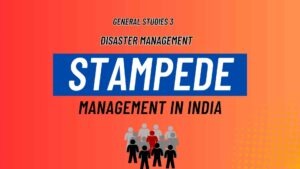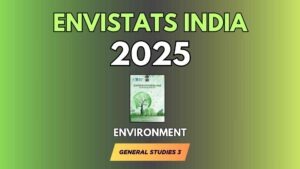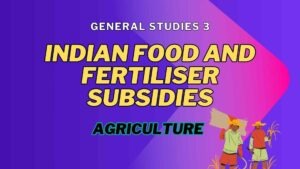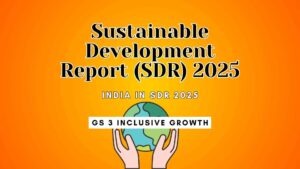Indian Food and Fertiliser Subsidies - Important UPSC Notes
Indian Food and Fertiliser Subsidies
🔍 Introduction to Subsidies:
A subsidy is financial assistance provided by the government to individuals or sectors to make essential goods or services more affordable and accessible.
Purpose:
Support vulnerable sections
Achieve public policy objectives
Promote economic efficiency and social welfare
✅ Types of Subsidies:
Direct Subsidies:
Direct cash or income transfers to beneficiaries
Example: PM-KISAN (₹6,000 per year to small farmers)
Indirect Subsidies:
Government reduces cost by price controls, tax exemptions, or public provisioning
Example: Subsidised foodgrains under NFSA, subsidised LPG cylinders
📊 Key Data Points:
Food Subsidy (FY26): ₹2.03 lakh crore
Fertiliser Subsidy (FY26): ₹1.56 lakh crore
Extreme Poverty Decline: 27.1% (2011) → 5.3% (2022)
PDS Coverage: Free foodgrains to 800 million people
Ration Card Reach: 84% households (FY 2022–23); 59% under BPL, AAY, PHH
Rural Gini Coefficient: Improved from 0.266 to 0.237 (indicating better income equality)
🚨 Why Do We Need Reforms?
1. Mismatch Between Poverty and Beneficiary Numbers
With poverty down to 5.3%, distributing food subsidies to 800 million people is fiscally unsustainable and inefficient.
2. Leakages in the System
Despite digitisation (e.g., Aadhaar seeding), issues like duplicate/ghost beneficiaries continue.
Example: Jharkhand found and removed thousands of fake ration cards.
3. Nutrition Security Is Ignored
PDS heavily focuses on cereals (rice, wheat), ignoring pulses, proteins, and micronutrient-rich foods.
Leads to calorie sufficiency but nutritional deficiency.
4. Fertiliser Imbalance and Soil Depletion
Overuse of urea (nitrogen-based fertilisers), and underuse of phosphorous and potassium, is degrading soil health.
Leads to declining agricultural productivity.
5. Fiscal Burden
Food and fertiliser subsidies consume a significant portion of the Union Budget, crowding out investment in:
Rural infrastructure
Irrigation projects
Cold storage and logistics
🔧 Government Initiatives So Far:
📦 Food Subsidy Reforms:
PMGKAY (PM Garib Kalyan Anna Yojana):
Provided 5 kg extra foodgrains/month during COVID-19
Now integrated into NFSA
Digitisation of Ration Cards:
Aadhaar-based seeding and use of ePOS (electronic Point of Sale) machines
Targeted Public Distribution System (TPDS):
Focus on Below Poverty Line (BPL) and Antyodaya Anna Yojana (AAY) beneficiaries
Diversification by States:
Some states include pulses, edible oils, iodised salt in PDS
🧪 Fertiliser Subsidy Reforms:
Neem-Coated Urea:
Reduces black marketing and improves nitrogen uptake
Nutrient-Based Subsidy (NBS):
Subsidy based on nutrient content (Nitrogen, Phosphorus, Potassium, Sulphur)
Encourages balanced fertiliser use
Direct Benefit Transfer (DBT):
Piloted for fertiliser subsidy—currently paid to companies, not directly to farmers
Price Controls:
Urea, DAP, MOP prices regulated to ensure affordability
🛠️ What More Needs to Be Done?
🧾 1. Food Coupons / Digital Wallets:
Provide digital vouchers (~₹700/family/month) to the poorest 15% population to buy nutrient-rich foods from the market.
🎯 2. Better Targeting of Subsidies:
Use data from Aadhaar, PM-KISAN, SECC to determine genuine beneficiaries.
Move toward graduated subsidies (based on income/need levels).
🌱 3. Fertiliser Coupons & Price Deregulation:
Give farmers coupons for fertiliser purchase instead of price caps.
Promote eco-friendly fertiliser usage.
🌾 4. Encourage Organic & Bio-Fertilisers:
Support natural farming, vermicomposting, and bio-inputs to reduce chemical dependency.
📊 5. Stronger Monitoring Mechanisms:
Integrate data sources (PM-KISAN, land records, etc.) to prevent inclusion/exclusion errors
🧠 6. Effective Communication with Farmers:
Prevent resistance to reforms through early dialogue, awareness campaigns, and trust-building.
🧭 Conclusion:
India has successfully reduced poverty and ensured food security through large-scale subsidies.
However, with changing rural realities and escalating fiscal costs, blanket subsidies are no longer sustainable.
Reforms must ensure:
Nutritional security, not just calorie security
Efficient targeting to reach the truly needy
Balanced fertiliser use for sustainable agriculture
Fiscal space for investment in long-term development
Way Forward: Move from universal subsidies to targeted, tech-enabled, and nutrition-sensitive support systems for inclusive and sustainable growth.
Mains-Based Questions on Indian Food and Fertiliser Subsidies
1.
Question:
“With poverty levels at historic lows, do blanket subsidies on food and fertilisers still serve their intended purpose? Critically examine the need for reforms in India’s subsidy regime.”
(GS Paper 3 – Indian Economy, Inclusive Growth)
Model Answer Framework:
Introduction:
Subsidies have historically played a crucial role in addressing poverty, ensuring food security, and supporting Indian farmers.
However, extreme poverty has declined from 27.1% in 2011 to 5.3% in 2022, raising questions about the efficiency of continuing blanket subsidies.
Body:
Why Blanket Subsidies Are No Longer Efficient:
Misalignment with current poverty levels: 800 million people continue to get subsidised food despite poverty being much lower.
Leakages and wastage: Ghost beneficiaries, duplicate ration cards, diversion of fertilisers to industries or neighboring countries.
Nutritional limitations: PDS focuses primarily on cereals (wheat, rice), neglecting protein and micronutrient needs.
Fertiliser misuse: Overuse of urea due to price controls has led to soil degradation and nutrient imbalance.
Fiscal burden: Combined food and fertiliser subsidy exceeds ₹3.5 lakh crore in FY26, crowding out capital investment.
Why Some Level of Subsidy is Still Needed:
Vulnerable sections like landless labourers, tribal communities, and marginal farmers still rely on state support.
Market prices for food and fertilisers are often volatile and unaffordable without intervention.
Acts as a counter-cyclical measure during inflationary or drought periods.
Need for Smart Reforms:
Targeting subsidies using SECC, PM-KISAN, Aadhaar, and land records.
Shifting from in-kind transfers to digital food coupons or wallets.
Fertiliser subsidy through DBT and promotion of balanced nutrient application.
Encouraging bio-fertilisers and organic farming.
Conclusion:
India must move towards targeted, nutrition-sensitive and environmentally sustainable subsidies, while ensuring no disruption to food security and farmer welfare.
2.
Question:
Discuss the challenges associated with India’s fertiliser subsidy policy and suggest reforms for ensuring soil health, farmer welfare, and fiscal prudence.
(GS Paper 3 – Agriculture, Subsidies, and Input Reforms)
Model Answer Framework:
Introduction:
India is one of the largest fertiliser consumers, and the fertiliser subsidy is crucial for ensuring affordable input supply to farmers.
Yet, the current system has created nutrient imbalance, soil degradation, and high fiscal burden.
Body:
Challenges in Current Fertiliser Subsidy Policy:
Urea Overuse: Cheap urea leads to excessive nitrogen use → soil acidity, nutrient depletion.
Neglect of P and K nutrients: Under-application affects balanced plant nutrition.
Environmental impact: Fertiliser runoff pollutes water bodies.
Market distortion: Controlled pricing discourages innovation and private investment.
Subsidy Inefficiency: Bulk of subsidy goes to manufacturers, not directly to farmers.
Reforms Needed:
Implement DBT to farmers instead of companies to promote demand-based application.
Fertiliser coupons or digital cards to give purchasing power to farmers.
Promote Nutrient-Based Subsidy (NBS) for all fertilisers, including urea.
Encourage Neem-coated urea, liquid biofertilisers, and natural farming practices.
Invest in soil health cards and awareness on balanced application.
Conclusion:
A balanced, targeted, and eco-friendly fertiliser policy is crucial for the next agricultural revolution in India that ensures productivity without compromising soil health and sustainability.
3.
Question:
Food security in India has been largely ensured through the Public Distribution System (PDS), but nutrition security remains a challenge. In this context, evaluate the limitations of the current PDS and suggest policy measures for reform.
(GS Paper 3 – Food Security and Nutrition)
Model Answer Framework:
Introduction:
India’s PDS is the world’s largest food distribution network, ensuring calorie security.
However, nutrition security (adequate proteins, vitamins, and minerals) remains unaddressed.
Body:
Limitations of PDS:
Mono-diet focus: Over-dependence on wheat and rice; negligible supply of pulses, oil, etc.
Leakages and corruption: Despite digitisation, many states report diversion or ghost beneficiaries.
One-size-fits-all approach: Uniform subsidy across economic strata—hurts targeting.
Storage and distribution inefficiencies: Poor warehousing, high food wastage.
Suggested Reforms:
Shift to Digital Food Coupons or Wallets: Provide freedom to buy varied food items (milk, eggs, etc.)
Revise PDS basket: Include fortified food, pulses, oil, salt, and region-specific items.
Strengthen Targeted PDS (TPDS) by using Aadhaar, SECC, land ownership, and income data.
Encourage community kitchens, decentralised procurement, and local nutrition models.
Integrate Mid-Day Meal and ICDS schemes to ensure children’s nutrition needs.
Conclusion:
India needs to evolve from food security to comprehensive nutrition security by modernising its subsidy delivery system, while protecting the most vulnerable.
Prelims Questions based on Indian Food and Fertiliser Subsidies
-
Stampede Management in India – Important UPSC Notes
A stampede occurred at Chinnaswamy Stadium, Bengaluru, during RCB’s IPL... -
EnviStats India 2025 – Important UPSC Notes
The 8th edition of EnviStats India 2025 was released by... -
Quantum Computing – Important UPSC Notes
Tech giants like Google, IBM, and China’s Jiuzhang have developed... -
Indian Energy Security – Important UPSC Notes
In 2025, India became the 4th largest economy in the... -
Indian Food and Fertiliser Subsidies – Important UPSC Notes
With poverty down to 5.3%, distributing food subsidies to 800... -
India in SDR 2025 – Important UPSC Notes
India in SDR 2025 has ranked 99th, entering the Top... -
Indian FDI Mystery- Important UPSC Notes
India received a 13.7% increase in total FDI (Gross FDI...








